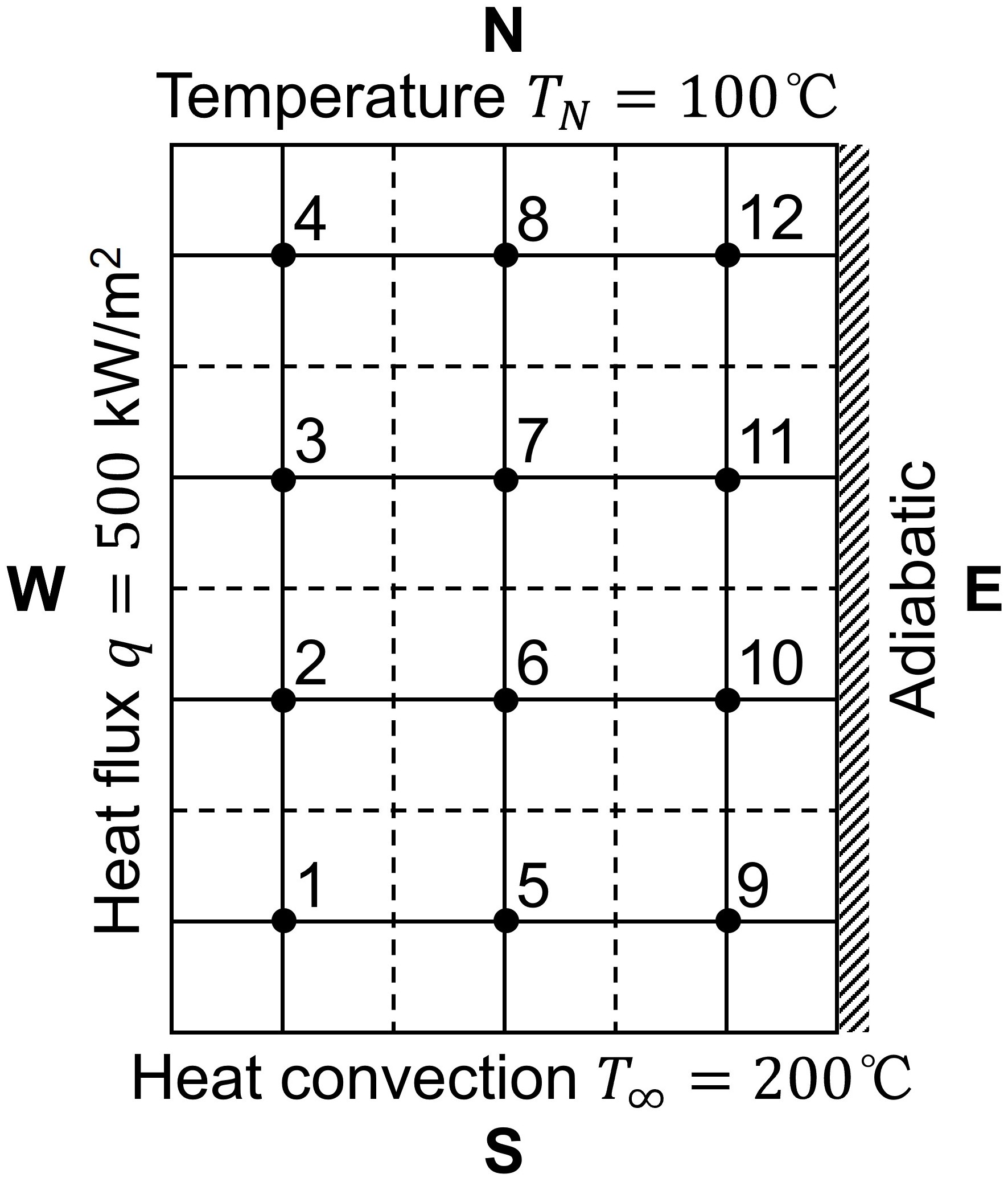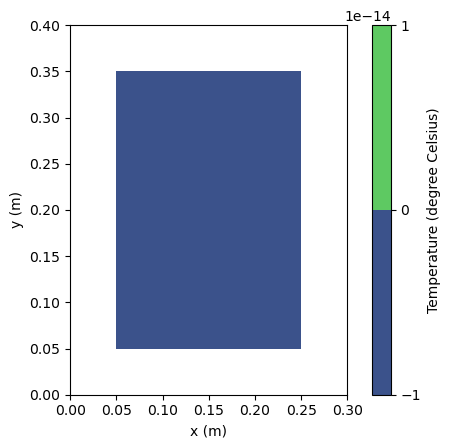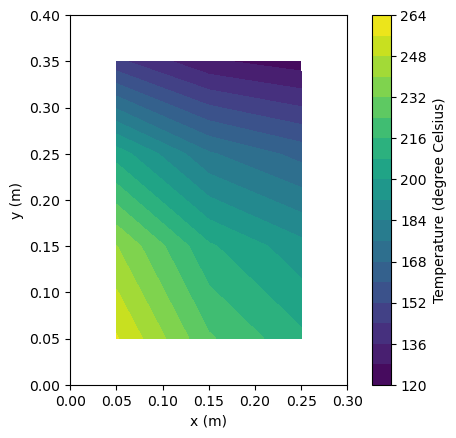2D steady-state diffusion#
Diffusion problems study the spreading of substances (e.g., heat, particles, or pollutants) over time due to random motion, governed mathematically by the diffusion equation. At steady state, the solution depends on boundary conditions (e.g., fixed values or fluxes at edges), with applications spanning heat transfer, environmental pollutant dispersion, biological transport, and material science. The problems are analytically solvable in simple geometries but often require numerical methods for complex scenarios.
Problem setup#
As shown in the figure, there is a two-dimensional heated plate with a length of \(L=0.3\) m, a height of \(H=0.4\) m, and a thickness of 0.01 m. The plate has a thermal conductivity of \(k=1000\) W/(m·K). The western boundary is subjected to a constant heat flux with a flux density of \(q=500\) kW/m\(^2\). The eastern boundary is adiabatic, while the southern boundary exchanges heat by convection with ambient air at a temperature of \(T_{\inf} = 200\) °C, with a convective heat transfer coefficient of \(h = 253.165\) W/(m\(^2 \cdot\)K). The northern boundary is maintained at a constant temperature of \(T_N = 100\) °C. Determine the temperature distribution within the plate.

The mathematical model for two-dimensional steady-state diffusion problem is
The boundary conditions are
Solve problem#
Define 2D grid#
Take a uniform grid \(\delta x = \delta x = 0.1\) m.
Discretize 2D diffusion equation#
There are nine different types of nodes we have to deal with separately. Make \(k = k_w = k_e = k_s = k_n\) and \(A = A_w = A_e = A_s = A_n\), derive the discrete equations for the internal and boundary nodes as following.
Internal Nodes 6 and 7
The discrete equation satisfied by the internal nodes in the plate is
where
Corner Node 1
The western boundary is subject to a constant heat flux, we have
On the east side, we have
The southen boundary exchanges heat with the ambient air by convection, we have
On the north side, we have
The overall source term becomes
Therefore, the discrete equation for Node 1 is
Edge Nodes 2 and 3
On the west side, we have the constant heat flux boundary
On the other sides, we have
So the discrete equations for Nodes 2 and 3 can be written as
Corner Node 4
On the west side, we still have the constant heat flux boundary, so we have
On the east and south sides, we have
On the north side, the temperature is fixed at 100 °C, so we have
The overall source terms becomes
Therefore, the discrete equation for Node 4 is
Edge Node 5
On the west, east and north sides, we have
On the south side, we have the convective heat exchange boundary
Therefore, the discrete equation for Node 5 becomes
Edge Node 8
On the west, east and south sides, we have
The northern side is the boundary with a fixed tempeture, so we have
Therefore, the discrete equation for Node 8 becomes
Corner Node 9
On the west and north sides, we have
On the south side, we have convective heat exchange, so
The eastern side is adiabatic, so we have
Therefore, the discrete equation for Node 9 is
Edge Nodes 10 and 11
On the west, south and north side, we have
The eastern side is adiabatic, so we have
Therefore, the discrete equations for Nodes 10 and 11 are
Corner Node 12
On the west and south sides, we have
The northern side is the boundary with a fixed tempeture, so we have
The eastern side is adiabatic, so we have
Therefore, the discrete equation for Node 12 is
Solve algebraic equations#
# Step 0: import the required libraries
import numpy as np
from matplotlib import pyplot as plt
import time
# Step 1: parameter declarations
lx = 0.3 # length of the plate
ly = 0.4 # height of the plate
nx = 3 # number of grid points in x-direction
ny = round(ly/lx*nx) # number of grid points in y-direction
dx = lx/nx # grid spacing in x-direction
dy = ly/ny # grid spacing in y-direction
x = np.linspace(0.5*dx, lx-0.5*dx, nx) # x-coordinates of the grid points
y = np.linspace(0.5*dy, ly-0.5*dy, ny) # y-coordinates of the grid points
h = 0.01 # plate thickness
area = h*dx # flux area
k = 1000 # coefficient for heat conduction
q = 500000 # heat flux at the west boundary
Tinf = 200 # ambient temperature in the south
h = 253.165 # convective heat transfer coefficient at the southern edge
Tn = 100 # constant temperature at the northern edge
# Step 2.1: set initial condition (Note the order of nx and ny)
T = np.zeros((ny, nx)) # a numpy array with all elements equal to zero
# Step 2.2: visualize initial temperature distribution
plt.figure() # create a new figure
cs = plt.contourf(x, y, T, levels=20)
plt.xlabel('x (m)')
plt.ylabel('y (m)')
plt.axis('scaled')
ax = plt.gca()
ax.set_xlim(0, 0.3)
ax.set_ylim(0, 0.4)
cbar = plt.colorbar(cs) # add color bar to the figure
cbar.ax.set_ylabel('Temperature (degree Celsius)')
plt.show() # show the figure

Question: How come the contour is shown only in the middle of the domain?
# Step 3: finite volume calculations
Told = np.zeros((ny, nx)) # placeholder array to advance the solution
Tdiff = 1 # temperature difference for convergence
cnt = 0 # counter for the number of iterations
t_start = time.perf_counter() # start time for performance measurement
while Tdiff > 1e-3: # loop until the difference is less than 1e-3
cnt += 1 # increment the counter
Told = T.copy() # copy the existing (old) values of T into Told
for row in range(ny):
for col in range(nx):
# left-bottom corner
if row == 0 and col == 0:
T[row, col] = ((k*area/dx)*Told[row+1, col] + ((k*area/dx))*Told[row, col+1] + q*area + area*Tinf/(1/h + dx/(2*k))) / (2*k*area/dx + area/(1/h + dx/(2*k)))
# right-bottom corner
elif row == 0 and col == nx-1:
T[row, col] = ((k*area/dx)*Told[row+1, col] + (k*area/dx)*Told[row, col-1] + area/(1/h + dx/(2*k))*Tinf) / (2*k*area/dx + area/(1/h + dx/(2*k)))
# left-top corner
elif row == ny-1 and col == 0:
T[row, col] = ((k*area/dx)*Told[row-1, col] + (k*area/dx)*Told[row, col+1] + (q*area + 2*k*area/dx*Tn)) / (4*k*area/dx)
# right-top corner
elif row == ny-1 and col == nx-1:
T[row, col] = ((k*area/dx)*Told[row-1, col] + (k*area/dx)*Told[row, col-1] + (2*k*area/dx*Tn)) / (4*k*area/dx)
# left boundary
elif col == 0:
T[row, col] = ((k*area/dx)*Told[row-1, col] + (k*area/dx)*Told[row+1, col] + (k*area/dx)*Told[row, col+1] + q*area) / (3*k*area/dx)
# right boundary
elif col == nx-1:
T[row, col] = ((k*area/dx)*Told[row-1, col] + (k*area/dx)*Told[row+1, col] + (k*area/dx)*Told[row, col-1]) / (3*k*area/dx)
# bottom boundary
elif row == 0:
T[row, col] = ((k*area/dx)*Told[row, col-1] + (k*area/dx)*Told[row, col+1] + (k*area/dx)*Told[row+1, col] + (area*Tinf/(1/h + dx/(2*k)))) / (3*k*area/dx + area/(1/h + dx/(2*k)))
# top boundary
elif row == ny-1:
T[row, col] = ((k*area/dx)*Told[row, col-1] + (k*area/dx)*Told[row, col+1] + (k*area/dx)*Told[row-1, col] + (2*k*area/dx*Tn)) / (5*k*area/dx)
# internal nodes
else:
T[row, col] = 0.25 * (Told[row, col-1] + Told[row, col+1] + Told[row-1, col] + Told[row+1, col])
# calculate the difference between the new and the old temperature distributions
Tdiff = np.sum(np.abs(T - Told))
if cnt % 10 == 0: # print every 100 iterations
print('Iteration {}: Tdiff = {:.4f}'.format(cnt, Tdiff))
# stop the timer and print the iteration results
t_end = time.perf_counter()
print('******************************************')
print('Final temperature difference: {:.4f}'.format(Tdiff))
print('Number of iterations: {}'.format(cnt))
print('Elapsed time: {:.3f} seconds'.format(t_end - t_start))
Iteration 10: Tdiff = 71.3782
Iteration 20: Tdiff = 39.7494
Iteration 30: Tdiff = 22.2378
Iteration 40: Tdiff = 12.4416
Iteration 50: Tdiff = 6.9609
Iteration 60: Tdiff = 3.8945
Iteration 70: Tdiff = 2.1789
Iteration 80: Tdiff = 1.2190
Iteration 90: Tdiff = 0.6820
Iteration 100: Tdiff = 0.3816
Iteration 110: Tdiff = 0.2135
Iteration 120: Tdiff = 0.1194
Iteration 130: Tdiff = 0.0668
Iteration 140: Tdiff = 0.0374
Iteration 150: Tdiff = 0.0209
Iteration 160: Tdiff = 0.0117
Iteration 170: Tdiff = 0.0065
Iteration 180: Tdiff = 0.0037
Iteration 190: Tdiff = 0.0020
Iteration 200: Tdiff = 0.0011
******************************************
Final temperature difference: 0.0010
Number of iterations: 203
Elapsed time: 0.004 seconds
# Step 4: visualize results after advancing in time
fig = plt.figure()
cs = plt.contourf(x, y, T, levels=20)
plt.xlabel('x (m)')
plt.ylabel('y (m)')
plt.axis('scaled')
ax = plt.gca()
ax.set_xlim(0, 0.3)
ax.set_ylim(0, 0.4)
cbar = plt.colorbar(cs)
cbar.ax.set_ylabel('Temperature (degree Celsius)')
plt.show()

We can check the final temperature at the center of the plate.
# Step 5: examine results of interest
print('The temperature at the plate center is {:.4f} degree Celsius.'.format(0.5*(T[ny//2, nx//2] + T[ny//2-1, nx//2])))
The temperature at the plate center is 193.1574 degree Celsius.
Exercise#
Check the grid independence. Increase the resolution until the numerical result (e.g., the temperature at the plate center) does not change any more.
Modify the code such that different spatial resolutions in the horizontal and vertical directions can be applied. (optional)